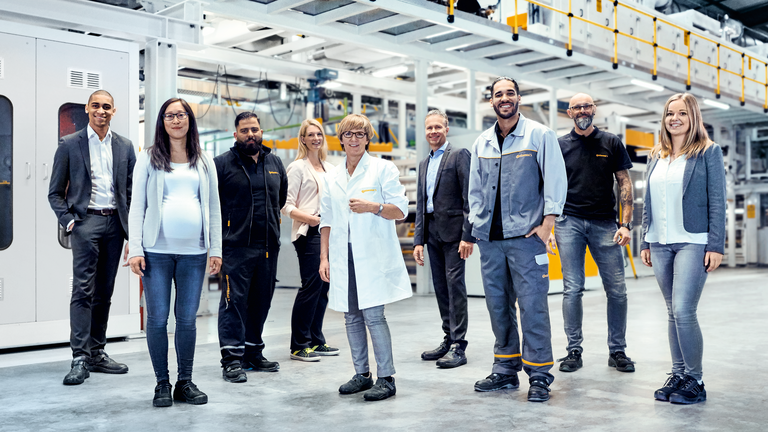Quality
No Compromises on Quality and Safety
At Continental, quality and safety are top priorities. Whether in production, development, or support functions, our teams work to ensure error-free processes and continuous improvement.
Continuous and multidisciplinary Improvement
Using structured quality methods and tools, we optimize process control and risk management. Customer satisfaction, supplier quality, and employee training are key focus areas.
Proactive Problem Solving
Quality managers use statistical process control to prevent issues before they occur. When issues arise, they implement corrective actions. Strong technical skills, assertiveness, and communication are essential. Quality management systems help us meet the highest standards in efficiency and customer satisfaction.
My Job Is Done When All Tires Have More Than One Life
Anja Schneider got off to a flying start at Continental as an industrial chemistry forewoman and has now been with the company for over 40 years: “I enjoy working with my team and the products we make. I’ve been with the company for a long time: I began my career at Continental back in 1980 with an apprenticeship as part of the “Girls in Men’s Professions” project and graduated as an industrial forewoman in the late 1980s. I work in ContiLifeCycle quality management in the Tires group sector – my 14th position in my career at Continental. My colleagues and I work in the retreading of truck tires and give them a new lease on life. To achieve this, we buy back tire carcasses and refurbish them. I am proud to be part of this company and want to stay with Continental until I retire. My motivation is to put a good tire on the road at the end of the day, thus ensuring greater safety and a sustainable planet at the same time.”
Discover Attractive Career Opportunities in the Field of Quality
A typical work day
The following daily schedule is just an example to illustrate what a typical day might look like. Naturally, the actual schedule may vary depending on individual preferences and circumstances.
I start my day by clocking in and quickly reviewing any new updates or issues from the previous shift. I meet with my team to go over the day’s priorities, which often include completing documentation for finished hoses, conducting quality inspections, and ensuring we meet customer requirements.
If I am in the role of Quality Coordinator, this meeting helps me get clarity on the current status of certification documentation and any upcoming deadlines for Vendor Data Books (VDBs) or Manufacturing Record Books (MRBs). I ensure that all required testing and post-production activities are aligned with our quality assurance standards.
After the check-in, I focus on reviewing the completed hoses that have passed through the inspection process. I verify that all necessary documentation, such as route cards, hydrostatic test charts, and inspection records, is available and correctly filed. As the Quality Coordinator, I ensure the correct Dunlop Oil & Marine documentation is attached to each order, preparing transmittals for the customer with detailed explanations of what is included—whether it is test certificates, SHUSH documentation, or a PED Declaration of Conformity.
If I am acting as a Quality Engineer during this time, I might be inspecting production outputs and over-inspecting in-process products to ensure they meet key quality characteristics. I also decide on the disposition of any off-standard products in coordination with the Quality Manager.
I take a quick break, grab some water, and check in with colleagues before getting back to the tasks at hand. These few minutes help me clear my mind before tackling the next set of responsibilities.
During this time, I focus on identifying and resolving quality issues. If I am working as a Quality Engineer, I might be reviewing SCRAP reduction initiatives and steering actions to address any inefficiencies. I engage in structured problem-solving using A3 methodology, which is essential for identifying root causes and implementing corrective measures to prevent recurrence.
As a Quality System & Process Auditor Specialist, this is when I conduct internal audits according to IATF 16949 or VDA 6.3 standards. I track any weaknesses found and hold meetings to define and implement countermeasures. These audits ensure we are adhering to our quality management system and meeting the requirements of both the company and the customer.
I take my 30-minute lunch break, usually in the cafeteria. It is a great time to relax and step away from the constant focus on audits and documentation. I use this time to reset before the second half of my shift.
After lunch, I conduct final quality inspections for any hoses or products that are ready for shipment. I ensure that all materials have the necessary documentation and certifications attached. If I am acting as a Quality Engineer, I may also assist in analyzing and reporting quality metrics like non-conformance costs, first-pass yield, and internal rejects. My goal here is to ensure all quality standards are met before the products leave the facility.
If I am in a quality systems role, I will be reviewing control plans for new products or updating existing ones based on feedback from process audits or customer requirements. I also make sure any deviations identified during the audits are documented and corrective actions are in place.
I spend this time organizing all QA documentation in accordance with internal and external requirements. As a Quality Coordinator, I ensure that radiographs from suppliers are properly filed and that all necessary certifications are included in the final documentation packages for customers. This is especially important when creating Vendor Data Books or Manufacturing Record Books, as these documents need to be collated precisely according to customer specifications.
If I am a Quality System & Process Auditor, I might be preparing reports to present to management, outlining the results of recent audits, identifying areas of improvement, and ensuring our quality management systems align with ISO 9001 and IATF 16949 standards.
At the end of my shift, I wrap up any unfinished tasks, ensure that all documentation is properly filed, and prepare notes for the next shift or for tomorrow’s tasks. If there are any urgent matters, I inform the QA Manager or team members to ensure smooth continuity. Once everything is in order, I clock out and leave for the day, feeling satisfied that we have maintained the highest quality standards and met our documentation requirements.



